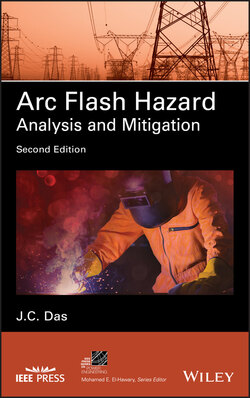Читать книгу Arc Flash Hazard Analysis and Mitigation - J. C. Das - Страница 34
1.11.1 Arc Flash Hazard with Equipment Doors Closed
ОглавлениеThere is some controversy in interpreting the intent of NFPA 70E, whether the arc flash hazard exists at all times, with the equipment door closed, or it exists only when the doors of an energized equipment are opened for maintenance? Let us first consider most common reasons for arc flash accidents:
human error
mechanical faults
failed connections, loose connections, and terminals
Adverse ambient conditions and pollution. This should consider pollution specific to plant operation, that is, corrosive gases and vapors may be present.
rodents.
Table 1.12 shows statistical data of arc flash incidents, when these can occur. This shows that some arc flash hazard exists, even when someone is walking around the closed-door electrical energized equipment, though this probability is relatively small. The IEEE Guide equations are based upon the hazard calculations with the door open. With the door closed, the hazard level will be less. It is not so easy to calculate it. The manufacturers are reinforcing the latching mechanisms and strengthening the doors, yet the withstand capability of the doors in closed position under an arc flash event is a question mark. Only when the equipment is arc resistant is the incident energy level outside the equipment zero, so long as no doors and panels that are not intended to be opened are not opened (see Chapter 13).
To resolve this conflict, NFPA 70E 2012 adds:
It is the collective experience of the Technical Committee on Electrical Safety in the Workplaces that normal operation of the enclosed electrical equipment, operating at 600V or less, that has been properly installed and maintained by qualified persons is not likely to expose the employee to an electrical hazard.
It is also the opinion of the committee that there is little risk in performing normal operations of electrical equipment and devices, such as opening and closing circuit breakers, motor control centers (MCCs), or starters. When the committee states “interacting with equipment in a manner that could cause an arc flash hazard,” it refers to operations, such as racking circuit breakers or installing and removing MCC buckets.
